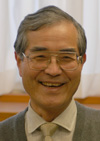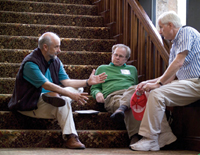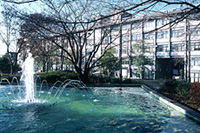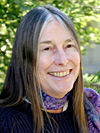Professor Yoji Totsuka, Director-General of KEK
KEK leads the world in neutrino physics and with its B-factory but Professor Totsuka notes that KEK is also heavily involved in R&D for the ILC with the international collaboration at the accelerator test facility (ATF). KEK is also working hard to establish and improve the SRF cavity technologies.
 Professor Totsuka
Professor Totsuka
|
The number of staff members at KEK is about a third of that of other major laboratories in the world. This is because large Japanese institutes such as KEK are required to cooperate closely with the industry from the beginning, explains Totsuka. This has several advantages such as the budget of the institute not being dominated by personnel costs and thus being more flexible and it also allow state-of-the-art technology to be transferred to and from the industry. This cooperation will even be further strengthened for the ILC.
Professor Totsuka explains that the Japanese administration is traditionally very cautious to give its opinions especially on big and expensive projects such as the ILC, but there is a constant exchange of information about it. Once Japan will have taken a decision, this decision will be reliable and will not be blurred at a later stage. ITER and the ILC share many common features such as establishing a truly international science center in Asia and attracting and stimulating bright young students and scientists in Asian countries but it is too early to evaluate the effect of the decision on the ITER site on a possible Japanese bid to host the ILC.
--Nicolas Delerue
|
 |
|
|
 |
Upcoming meetings, conferences, workshops
Nanobeams 2005
Kyoto, Japan, 17-21 October 2005
European GDE Meeting
Oxford, England, 24-25 October 2005
Damping Rings Meeting
CERN, Switzerland, 9-11 November 2005
ECFA ILC Workshop
Vienna, Austria, 14-17 November 2005
TESLA Technology Collaboration Meeting
Frascati, Italy, 5-6 December 2005
GDE Meeting
Frascati, Italy, 7-10 December 2005
2006 LCWS 2006
Bangalore, India, 9-15 March 2006
|

The main stairwell of the conference center was an ad hoc meeting spot for many Snowmass participants. Pier Oddone (left), director of Fermilab, discusses ILC plans with Robin Staffin (center), director of the Department of Energy's Office of High Energy Physics, and Fred Gilman, chair of DOE's High Energy Physics Advisory Panel.
Full article from symmetry
|
|
 |
SMTF Collaboration Addresses ILC Linac Technical Issues

Every chair was filled at the closing talks of the SMTF meeting last Friday. |
Focusing mainly on technical issues related to the International Linear Collider linac, the SMTF (Superconducting Module &Test Facility) Collaboration met at Fermilab on 5-7 October. Members from KEK, DESY, Italy, Daresbury in the UK and several U.S. institutions and universities divided into working groups. A number of scientists from around the globe also participated virtually via videoconference connections and streaming video.
“With members from Fermilab, SLAC, JLab, Argonne, LBNL, MSU, LANL, NIU, Penn and Cornell, U.S. collaboration was very strong at the meeting”, said Cornell University physicist Hasan Padamsee, chair of the SMTF technical board. Established in early 2004, a group of U.S. labs and institutions interested in superconducting radiofrequency technology created the SMTF collaboration to work on such projects as the ILC FEL and ERL light sources. The ILC became a top priority for the collaboration after the ITRP decision in August 2004. “The goal for this meeting was to address two of the major technical issues for the ILC linac – reproducibility in cavity performance and a cryomodule design best suited for ILC”, Padamsee said. “We were very productive.”
Read more
--Elizabeth Clements
|
 |
|
|
Kyoto University Hosts Nanobeam 2005 Next Week

Uji Campus, Kyoto University |
Recently very tiny beams with nanometer-scale size have attracted increasing interest by particle physics whose aim is to investigate the internal structure of `elementary' particles at a future linear collider such as the ILC or CLIC. New demands on beam quality, beam-optical systems, diagnostics, feedback, and especially stabilization of beam line components including the suppression of natural ground motion have stimulated scientists' frontier spirit in order to realize nanometer beam size and efficient collision in the future linear collider.
Read more
--Junji Urakawa, KEK
|
|
 |
Global Group 1
As I discussed in this column last week, the starting point for us in determining the baseline configuration for the ILC is a set of top-level physics parameters agreed to by the global community and contained in a report created by an international ICFA / ILCSC subcommittee dated September 30, 2003 and entitled, “Parameters for the Linear Collider.” This report gives us the basic parameters like luminosity, energy reach and other crucial physics parameters. The report gives the maximum energy of the ILC as 500 GeV in the center-of-mass, and states that the machine should have the future option of extending the energy to ~1 TeV.
 Nan Phinney
Nan Phinney
|
We created Global Group 1 for Snowmass, in order to translate this physics parameter set into overall machine parameters for the baseline ILC. This global group was to be run by Tor Raubenheimer, Nick Walker and Kaoru Yokoya, but Tor hurt his leg in an unfortunate accident and was not able to participate in the Snowmass meeting. Fortunately, Nan Phinney was able to very ably step-in for Tor during the workshop.
The strategy developed by this group was not to develop a single parameter set, but rather to determine a range of values for the key parameters that could achieve the basic goals. Four self-consistent parameter sets were studied, in which key parameters are traded off against each other in order to achieve the desired luminosity goal. The combination of these sets then give a parameter space where the machine could achieve the goals (in this case L = 2 1034 cm2sec-1). Each parameter set tends to push the achievable limits of one or more specific sub-systems. The four sets consisted of a nominal set, a set with reduced bunch charge by a factor of two, a set with increased vertical beam size from emittance growth by a factor of two, and finally a set with lower power by reducing the number of bunches by a factor of two.
Read more
--Barry Barish
Director's Corner Archive
|
 |
|
|
 |
Enroll Now for Winter U.S. Particle Accelerator School
The U.S. Particle Accelerator School offers university-style credit courses not otherwise available to the community of science and technology. This year, their winter program is sponsored by Arizona State University and will be held from January 16-27, 2006 in Phoenix, AZ. For course outlines and an electronic application form, please visit http://uspas.fnal.gov Successful completion of a two-week course earns three semester hours of graduate credit from Arizona State University. Auditors are welcome. Financial support is available to graduate students. For further information and a full course listing, please contact the USPAS Office at uspas@fnal.gov, phone 630-840-3896.
New ILC Members?
Does your group have new members working on ILC-related R&D? Did new graduate students join your Institute? Let the GDE Communicators know when new collaborators join the ILC R&D, and we will announce it in ILC NewsLine.
ILC Related Preprints
hep-ph/0510061 - Contrasting the anomalous and the SM-MSSM couplings at the Colliders, 5 Oct. 2005
hep-ph/0510088 - Dark Matter with (very) heavy SUSY scalars at ILC, 7 Oct. 2005
hep-ph/0510029 - CP-odd observables in neutralino production with transverse e+ and e- beam polarization, 3 Oct. 2005
hep-ph/0510075 - Partially composite two-Higgs doublet model, 6 Oct. 2005
If you recently released a preprint related to the ILC, let us know!
|
|